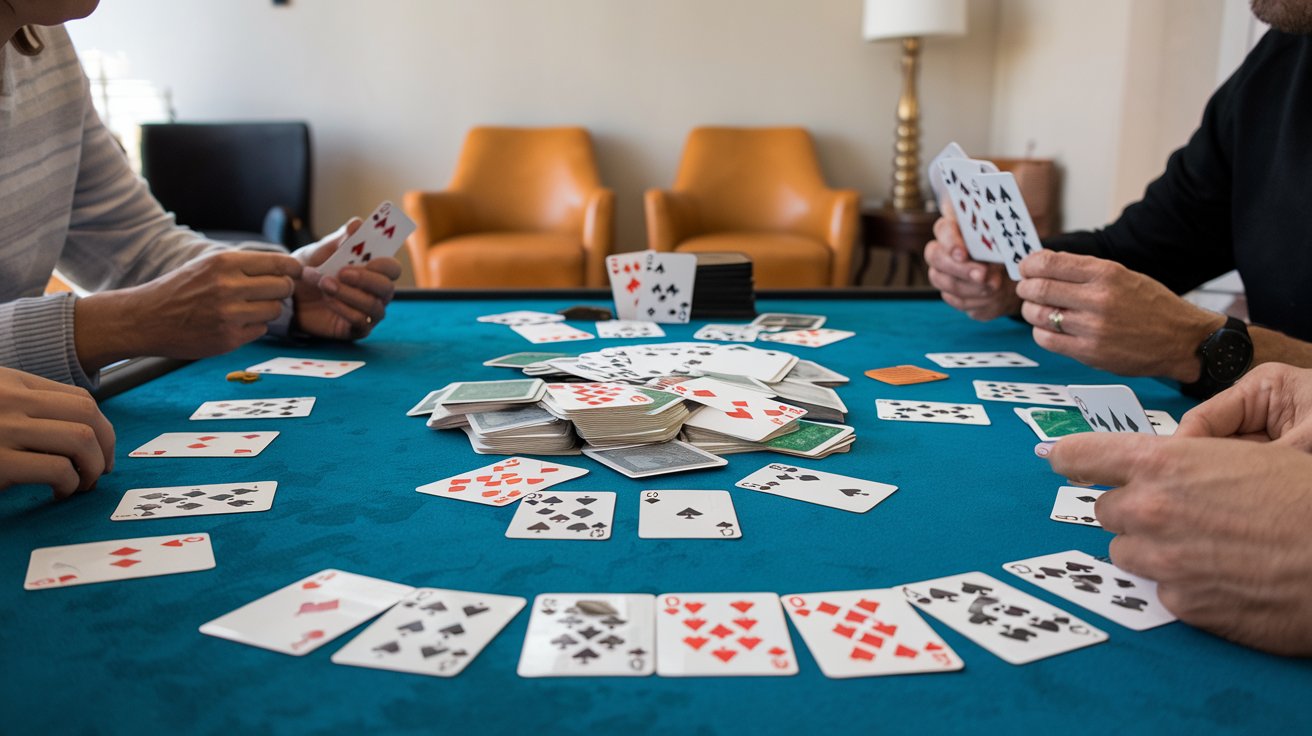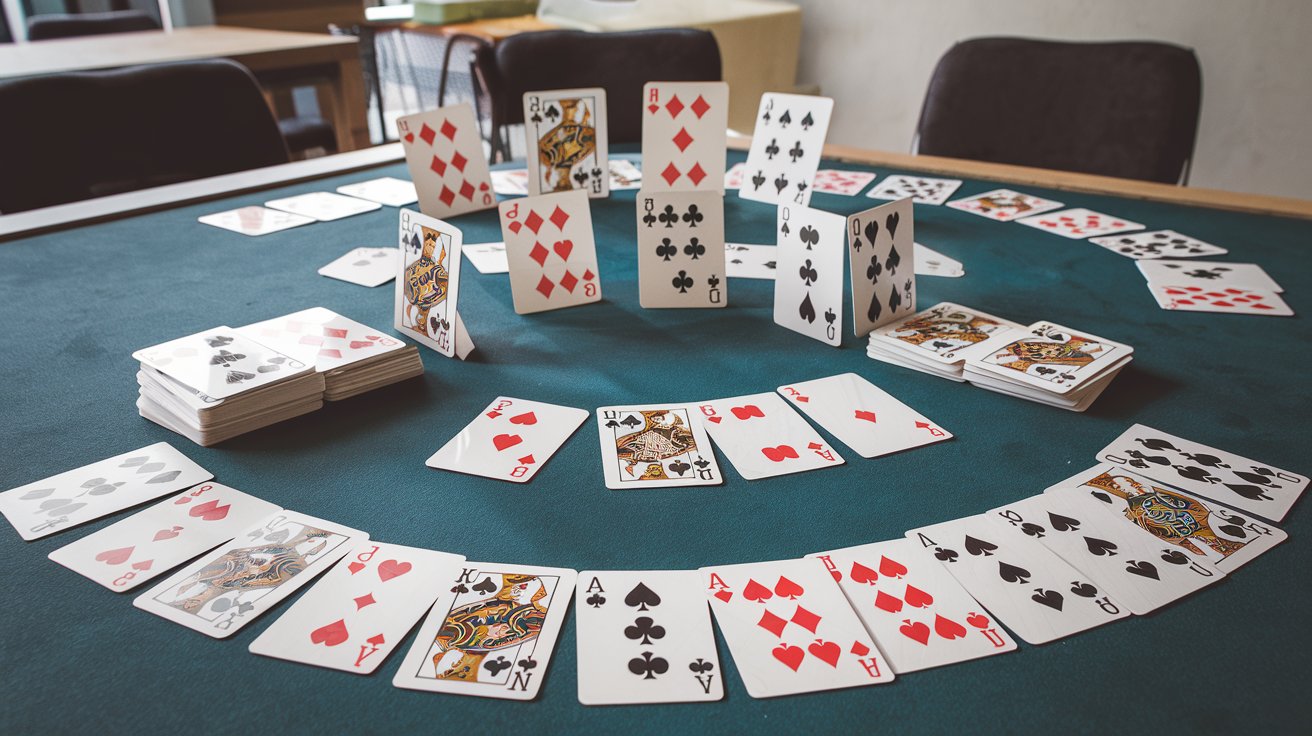Rummy is a classic card game enjoyed by millions worldwide, but one of the most common questions that new players ask is: “How many cards do you need to play rummy?” The answer isn’t as straightforward as it might seem. The number of cards dealt in rummy varies based on the specific variation you’re playing, the number of participants, and even regional or house rules. In this comprehensive guide, we’ll explore everything you need to know about card counts in various rummy games, helping you prepare for any rummy variation you might encounter.
The Basics: Standard Deck Requirements
Before diving into specific card counts, let’s establish what constitutes a standard deck for rummy games:
Standard 52-Card Deck
Most rummy variations use a standard 52-card deck consisting of:
- Four suits: hearts (♥), diamonds (♦), clubs (♣), and spades (♠)
- Each suit contains 13 cards: Ace, 2-10, Jack, Queen, and King
Jokers and Wild Cards
Many rummy variants incorporate jokers or designated wild cards:
- Some games use 1-2 jokers from the box
- Others designate a random card as the “wild card” for a particular game
- Wild cards can typically substitute for any card needed to complete a valid combination
Now that we understand the basic deck requirements, let’s explore how many cards are dealt in different rummy variations.
Classic Rummy Card Counts

Basic Rummy (Straight Rummy)
In the most traditional form of rummy, the number of cards dealt depends on the number of players:
- 2 players: 10 cards each
- 3-4 players: 7 cards each
- 5-6 players: 6 cards each
The remaining cards form the stock pile (also called the draw pile), with the top card turned face up to start the discard pile.
Why These Numbers?
The card counts in basic rummy are carefully balanced to:
- Give players enough cards to form potential combinations
- Leave sufficient cards in the stock pile for gameplay
- Ensure the game moves at a good pace
Too many cards would make hands unwieldy and extend gameplay significantly, while too few would limit strategic options and combination possibilities.
Popular Rummy Variations and Their Card Counts

Different rummy variations have evolved their own standards for how many cards each player receives. Let’s examine the most popular versions:
Gin Rummy
Gin Rummy, developed in the early 20th century, has become one of the most popular two-player rummy games.
- Number of players: 2 (occasionally 3)
- Cards per player: 10
- Deck: Standard 52-card deck (no jokers)
In Gin Rummy, the goal is to form your cards into sets and runs while minimizing the point value of your unmatched cards (known as “deadwood”). The game ends when a player “knocks” (having 10 or fewer points in deadwood) or goes “gin” (no deadwood).
Oklahoma Gin
A variation of Gin Rummy with a unique twist:
- Cards per player: Initially 10, but the “knock count” (maximum allowed deadwood) decreases by 10 points after each hand
- Deck: Standard 52-card deck
Continental Rummy (Liverpool Rummy)

This popular multiplayer variation requires multiple decks:
- Number of players: 3-8
- Cards per player: 10
- Deck: Two standard decks plus jokers for 3-4 players; three decks for 5-8 players
Continental Rummy features multiple rounds with different combination requirements, making the 10-card count essential for achieving the complex combinations needed.
Canasta
Canasta, which became hugely popular in the 1950s, uses significantly more cards:
- Number of players: 4 (playing in partnerships)
- Cards per player: 11 (for a total of 22 cards per partnership)
- Deck: Two standard decks plus jokers (108 cards total)
The higher card count in Canasta accommodates its unique goal of creating “canastas” – melds of seven cards of the same rank.
500 Rummy
A fast-paced variation with a distinctive dealing pattern:
- Number of players: 2-8
- Cards per player: 7 (for 2 players), 7 (for 3-4 players), 6 (for 5 players), 5 (for 6 players), 4 (for 7-8 players)
- Deck: One standard deck for 2-3 players; two decks for 4-8 players
The decreasing card count with more players ensures that enough cards remain in the stock pile for meaningful gameplay, even with larger groups.
Rummy 500
Similar to 500 Rummy but with different scoring:
- Number of players: 2-8
- Cards per player: Same pattern as 500 Rummy
- Deck: One or two standard decks depending on player count
Indian Rummy Variations
Indian Rummy games have gained tremendous popularity and feature their own card count standards:
13-Card Indian Rummy
The most popular form of rummy in India:
- Number of players: 2-6
- Cards per player: 13
- Deck: One standard deck for 2 players; two decks plus jokers for 3-6 players
The 13-card count is fundamental to Indian Rummy’s requirements: players must form at least two sequences (runs), one of which must be a “pure sequence” without wild cards.
21-Card Rummy
A more complex Indian variation:
- Number of players: 2-4
- Cards per player: 21
- Deck: Two standard decks plus jokers
With 21 cards per player, this variation requires more mental tracking and typically features longer gameplay.
Points Rummy
A faster Indian rummy variation:
- Number of players: 2-6
- Cards per player: 13
- Deck: One or two standard decks plus jokers, depending on player count
The 13-card structure remains consistent across most Indian rummy variants, creating a standardized experience despite rule variations.
Factors That Influence Card Counts in Rummy
Several factors determine how many cards are dealt in rummy games:
1. Player Count
As seen across variations, the number of players directly impacts how many cards each receives. More players generally means fewer cards per player to ensure a sufficient stock pile remains.
2. Deck Count
Many rummy variations adjust the number of decks based on player count:
- Single deck: Typically for 2-3 players
- Double deck: Common for 4-6 players
- Triple deck: Sometimes used for 7+ players
3. Game Complexity
More complex variations often require more cards per player:
- 7 cards: Common for basic rummy
- 10 cards: Standard for Gin Rummy and many international variations
- 13 cards: Typical for Indian Rummy
- 21 cards: Found in more complex variants
4. Game Duration
The number of cards dealt influences how long a game will last:
- Fewer cards generally means shorter rounds
- More cards typically results in longer, more strategic games
Special Rummy Card Count Scenarios
Some unique situations affect how many cards players receive:
Tournament Rules
Official rummy tournaments may modify standard card counts to:
- Standardize gameplay across multiple rounds
- Accommodate time constraints
- Create balanced competition
House Rules
Many families and friend groups develop their own card count preferences:
- Some prefer dealing more cards for longer, more strategic games
- Others opt for fewer cards to keep games brief and accessible
- These adjustments often reflect the specific preferences and skill levels of regular players
Teaching Games
When introducing new players to rummy, veterans sometimes recommend:
- Starting with fewer cards (5-7) to make hand management easier
- Playing with open hands to demonstrate strategy
- Gradually increasing to standard card counts as players gain experience
How Card Count Affects Strategy
The number of cards you’re dealt significantly impacts how you approach a rummy game:
Fewer Cards (5-7)
With fewer cards:
- Players focus on forming a single strong combination quickly
- Discarding becomes more critical as each card represents a larger percentage of your hand
- Games tend to move faster with more emphasis on efficiency
Medium Card Count (10-11)
With a moderate number of cards:
- Players can work toward multiple combinations simultaneously
- More flexibility exists for card retention and strategic waiting
- Balance between offense (building your combinations) and defense (blocking opponents) becomes important
Higher Card Count (13+)
With more cards:
- Players must manage complex hands with multiple potential combinations
- Memory and tracking become crucial skills
- Long-term planning takes precedence over quick completion
Optimal Player Counts for Different Rummy Games
Based on card distribution, certain player counts work better for specific rummy variations:
2 Players
Two-player rummy games often feature more cards per player (10-13) and work well with:
- Gin Rummy
- Oklahoma Gin
- 2-player 13-Card Rummy
3-4 Players
The “sweet spot” for many rummy variations, 3-4 players allows for:
- Good card distribution (typically 7-10 cards each)
- Dynamic interaction without excessive waiting between turns
- Balanced competition
- Examples: Basic Rummy, 500 Rummy, Indian Rummy
5+ Players
Larger groups typically receive fewer cards per player (4-6) and are best suited for:
- Social, casual gameplay
- Variations specifically designed for larger groups
- Games using multiple decks
- Examples: Canasta (with partnerships), Continental Rummy
Practical Tips for Different Card Counts
Depending on how many cards you’re dealt, these strategies can help optimize your gameplay:
For Smaller Hands (5-7 cards)
- Focus on completing one strong combination quickly
- Discard high-point cards early if they don’t fit your strategy
- Pay close attention to the discard pile for opportunities
For Medium Hands (8-12 cards)
- Work toward multiple potential combinations
- Balance between keeping flexible cards and minimizing deadwood
- Develop a primary and backup strategy
For Larger Hands (13+ cards)
- Organize your hand by potential combinations
- Prioritize forming pure sequences first (especially in Indian Rummy)
- Consider keeping notes for card tracking in complex games
- Discard strategically to avoid helping opponents
Frequently Asked Questions About Rummy Card Counts
Can I adjust the number of cards dealt for casual games?
Absolutely! While traditional card counts exist for each variation, casual games can modify these counts to:
- Accommodate player preferences
- Adjust game duration
- Make the game more accessible for beginners
What’s the minimum number of cards needed for a satisfying rummy game?
Most rummy experts suggest at least 5-6 cards per player provides enough strategic depth while still allowing for meaningful gameplay.
How do card counts affect game duration?
As a general rule:
- 5-7 cards per player: 10-15 minutes per round
- 8-12 cards per player: 15-30 minutes per round
- 13+ cards per player: 30+ minutes per round
These estimates vary based on player experience and specific rule variations.
What happens if we run out of cards in the stock pile?
If the stock pile is depleted before anyone goes out:
- In most variations, the discard pile (except the top card) is shuffled to create a new stock pile
- Some variants declare the hand a draw if this happens
- House rules often determine the specific procedure
Conclusion: Finding Your Ideal Rummy Card Count
The beauty of rummy lies in its flexibility and adaptability. While traditional card counts exist for each variation, don’t be afraid to experiment with adjustments that suit your group’s preferences.
If you’re new to rummy, start with basic rummy using the standard card counts:
- 10 cards for 2 players
- 7 cards for 3-4 players
- 6 cards for 5-6 players
As you become more comfortable with the game mechanics, explore other variations with different card counts to discover which version provides the most enjoyable experience for you and your fellow players.
Remember that the “right” number of cards is ultimately the one that creates the most engaging, strategic, and enjoyable experience for your specific group of players. Whether you’re playing with a traditional 10-card Gin Rummy hand or managing 21 cards in a complex Indian variation, the core pleasure of rummy remains the same: forming satisfying combinations, outthinking your opponents, and enjoying the perfect blend of skill and luck that has made rummy a beloved card game worldwide.

Zareb Saleh is a journalist at Gulf Today and a ghostwriter for Gameoholic, specializing in gaming, technology, and digital culture. With a keen eye for industry trends, he delivers insightful stories that engage and inform readers.
